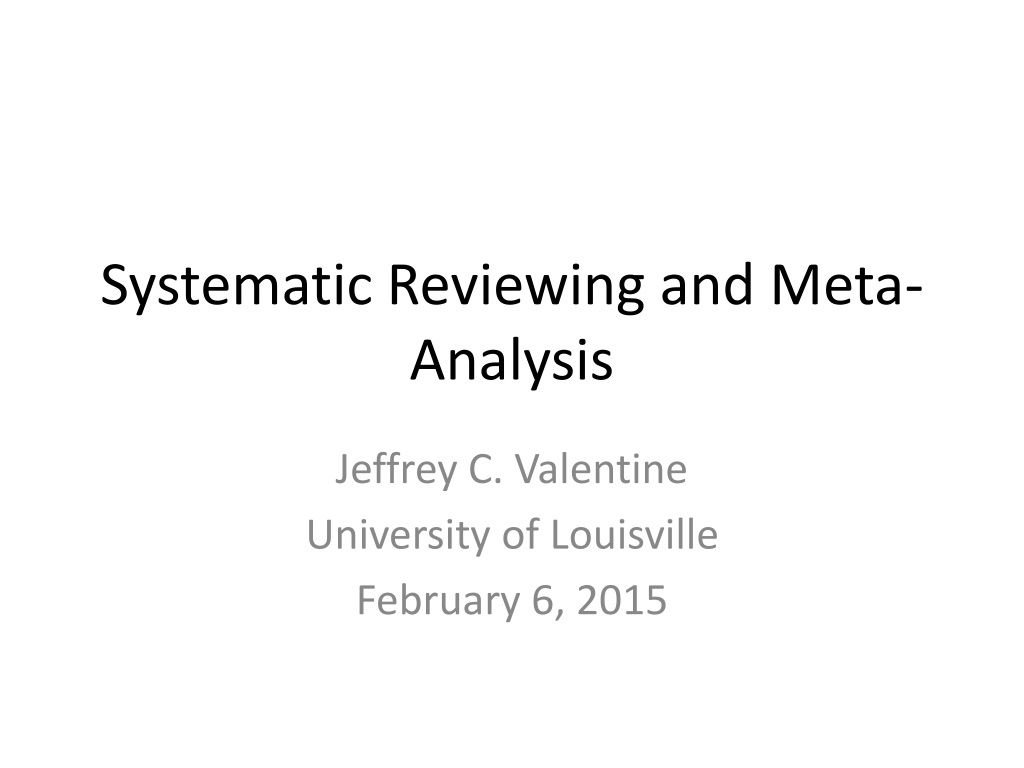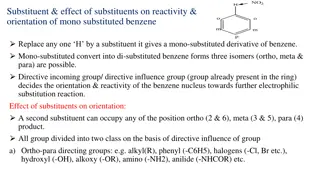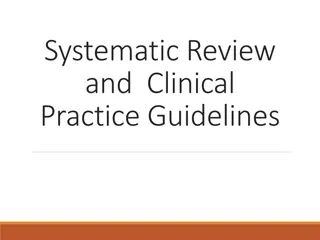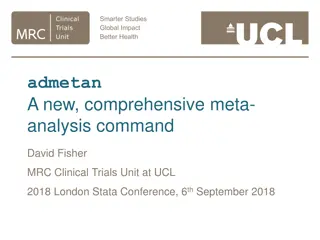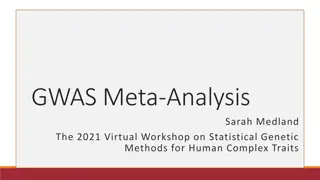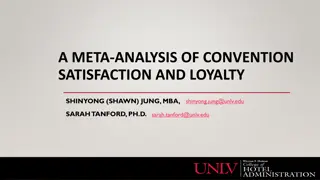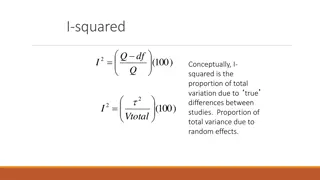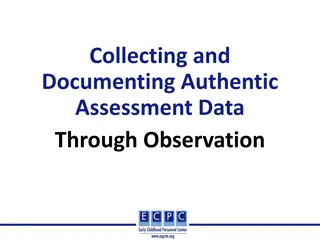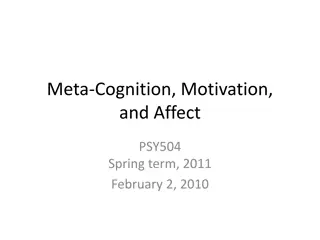Systematic Reviewing and Meta-Analysis
Explore the significance of systematic reviewing and meta-analysis in research literature, including definitions, options for conducting reviews, and reasons for the shift away from narrative reviewing. Discover the essential principles and future directions of systematic review practices.
Download Presentation

Please find below an Image/Link to download the presentation.
The content on the website is provided AS IS for your information and personal use only. It may not be sold, licensed, or shared on other websites without obtaining consent from the author.If you encounter any issues during the download, it is possible that the publisher has removed the file from their server.
You are allowed to download the files provided on this website for personal or commercial use, subject to the condition that they are used lawfully. All files are the property of their respective owners.
The content on the website is provided AS IS for your information and personal use only. It may not be sold, licensed, or shared on other websites without obtaining consent from the author.
E N D
Presentation Transcript
Systematic Reviewing and Meta- Analysis Jeffrey C. Valentine University of Louisville February 6, 2015
Plan for Today Definition of and rationale for systematic reviewing / meta-analysis Brief history Basic principles Conducting a simple meta-analysis Five questions to help evaluate the quality of a systematic review Future directions Your goals??
Why Do We Need a Systematic Approach to Reviewing Studies?
Definitions Systematic review A summary of the research literature that uses explicit, reproducible methods to identify relevant studies, and then uses objective techniques to analyze those studies. The goal of a systematic review is to limit bias in the identification, evaluation, and synthesis of the body of relevant studies that address a specific research question. Meta-analysis Statistical analysis of the results of multiple studies Often conflated with systematic review Not all meta-analyses are based in a systematic review, and not all systematic reviews result in a meta-analysis
What are Some of the Options for Conducting a Review? Narrative review: impressionistic determination of what a literature says ( I carefully read and evaluated 15 studies and it seems clear that ) Historically, the only method that was used Still relatively common today Vote count: Comparing the statistical significance of the results across studies Sometimes used in conjunction with a narrative review process Lists of effective programs: Require that at least two good studies with statistically significant results exist Lists of evidence based practices Systematic review and meta-analysis
Why Did We Move Toward Systematic Reviewing and Away From Narrative Reviewing? Recognition that reviews should be held to the same standards of transparency and rigor as primary studies Methodological improvements needed to help address Reporting biases (publication bias, outcome reporting bias) Need for transparency and replicability Study quality assessments Statistical improvements needed to help address Reporting biases Efficient processing of lots of information Moderator effects Study quality Study context variables (sample, setting, etc.)
Publication Bias Tendency for studies lacking statistical significance on their primary findings to go unreported Difficult problem because it is hard to detect estimate how much of an impact it is having if believed to be present
Outcome Reporting Bias Emerging evidence base on ORB Medicine (Chan & Altman, 2005; Vedula et al., 2009) Education Pigott et al. Examined dissertations in education that were later published Statistically significant dissertation findings were about 30% more likely to appear in subsequent journal publication than nonsignificant (OR = 2.4)
Scientists Have Been Thinking About How to Integrate Studies for a Long Time James Lind, English naval surgeon (18th Century): ...it became requisite to exhibit a full and impartial view of what had hitherto been published on the scurvy ... by which the sources of these mistakes may be detected. 1904: K. Pearson. Report on certain enteric fever inoculation statistics. British Medical Journal, 3, 1243-1246. 1932: R. A. Fisher. Statistical Methods for Research Workers. London: Oliver & Boyd. it sometimes happens that although few or [no statistical tests] can be claimed individually as significant, yet the aggregate gives an impression that the probabilities are lower than would have been obtained by chance. (p.99, emphasis added) 1932: R. T. Birge. The calculation of errors by the method of least squares. Physical Review, 40, 207-227.
Resurgence in the 1970s Explosion of research since the 1960 s About 100 randomized experiments in medicine per year in the 1960 s About 20,000 randomized experiments in medicine per year today 1978: R. Rosenthal & D. Rubin. Interpersonal expectancy effects: The first 345 studies. Behavioral and Brain Sciences, 3, 377-415. 1979: G. V. Glass & M. L. Smith. Meta-analysis of research on class size and achievement. Educational Evaluation and Policy Analysis, 1, 2-16. Over 700 estimates 1979: J. Hunter, F. Schmidt & R. Hunter. Differential validity of employment tests by race: A comprehensive review and analysis. Psychological Bulletin, 86, 721-735. Over 800 estimates
Resurgence in the 1970s (contd) Given the potential for reporting biases e.g., publication bias And the likely presence of moderator effects e.g., some people are more likely to elicit interpersonal expectancy effects than others And the likely variation in study quality across studies And the sheer number of studies A narrative reviewer simply has no hope of arriving at a systematic, replicable, and valid estimate of the main effect and the conditions under which it varies
Steps in the Systematic Review Process SRs are a form of research Follow basic steps in the research process: Problem formulation Sampling Like a survey, except surveying studies not people Studies are the sampling unit Sampling frame = all relevant studies Sample = studies available for analysis Data collection Data derived (extracted) from studies (usually two trained coders working independently) Study quality assessments Analysis Qualitative (descriptive, study quality assessment) Quantitative (effect sizes, meta-analysis) Reporting
Basic Principles of Systematic Reviewing and Meta-Analysis Conduct a thorough literature search looking for all relevant studies Systematically code (survey) studies for information Study context Participants Quality indicators Combine effects using a justifiable weighting scheme (like inverse variance weights)
Study Quality Assessments Study quality will likely vary (sometimes quite a bit) from study to study Study quality often covaries with effect size Therefore, meta-analytic effects may vary as a function of study quality Therefore, every good systematic review needs to deal with study quality thoughtfully
Methods People use to Address Study Quality (All Bad!) Ignore it Treat publication status as a proxy for study quality If published then good else bad Use a study quality scale
Quality Scales Do Not Work as Intended J ni et al. (1999) Found an existing meta-analysis on the effects of a new drug on post-operative DVT Found 25 quality scales Most (24 of 25) published in peer-reviewed medical journals Conducted 25 separate meta-analyses Each one used a different quality scale Were interested in what the high quality studies said about the drug relative to the low quality studies What did they find?
Jni et al. (1999) Results In about 50% of the meta-analyses, the high and low quality studies agreed about the effectiveness of the drug In about 25% of the meta-analyses high quality studies suggested the new drug was more beneficial than the old low quality studies said it was no better then the old drug In about 25% of the meta-analyses high quality studies suggested the new drug was no better than the old drug low quality studies suggested the new drug was more beneficial than the old The conclusion about the effectiveness of the new drug depended (in part) on the quality scale chosen
Implications of Jni et al. Study quality doesn t matter in this area And/or The quality scales were so bad that they masked the effects of study quality
Weaknesses of Study Quality Scales Different numbers of items suggests different criteria in use (some are more comprehensive than others) Different weightings of same criteria Even with the same number of criteria, the same aspect of study quality can have a different weight across scales Possibility that biases may act in opposite directions is ignored Difference between study quality and reporting quality is ignored Reliance on single scores to represent quality Study A: high internal validity, low external validity = 80 Study B: low internal validity, high external validity = 80
Why Are Study Quality Assessments So Hard to Develop? Study quality is almost certainly context dependent A threat to the validity of one study may not be a threat to the validity of another study Valentine & McHugh (2007) on attrition in randomized experiments in education Means that it is hard to build an evidence base Study quality is multidimensional Study quality indicators may not add up in expected ways
Study Quality Assessment: Best Practices Know your research context What are the likely markers of quality? Markers that likely matter a lot Consider excluding studies that do not have the trait e.g., in a drug treatment study I would be very worried about the effects of attrition Markers that might matter less Code studies for these, and explore how the are associated with variations in effect size
Study Quality Assessment Best Practices: Example Internal validity is a prime concern in nonrandomized experiments Controlling for important and well-measured covariates can help, but what s an important covariate? Answer depends on the context of the research question What was the selection mechanism? Specific answer will vary from question to question
Side Note: Comparability in Nonrandomized Experiments A randomized experiment involves forming study groups randomly (e.g., a coin flip) Main benefit is that we can assume that groups are equivalent on all measureable and unmeasurable variables This facilitates interpretation of study results A nonrandomized experiment is a study in which participants were not randomly assigned to conditions e.g., someone else chose the condition for them; participants selected their conditions, etc. Nonrandomized experiments are problematic because we don t know if participants in different groups are comparable
Conditions Under Which Nonrandomized Studies May Approximate RCTs Scholars have used within study comparisons to investigate this Within study comparison = randomly assign participants to an RCT or nonrandomized experiment If RCT, randomly assign to treatment or control If nonrandomized, use another method to form groups (e.g., let participants choose) Important to know a lot about the selection mechanism
Selection Mechanism (Example) Adapted from Shadish et al. (2008) Q: What determines whether an individual will choose to participate in a math vs. vocabulary intervention? Math ability Verbal ability Math anxiety Etc. These were derived from a thorough review of both theoretical and empirical literatures Quality judgments are best made by individuals with a deep understanding of the research context, and developing this understanding might require research!
What Do Within Study Comparisons Tell Us? Develop a rich understanding of the selection process e.g., why participants chose to participate in one condition vs. another Good pretest measures help a lot Measure the relevant variables well Do not rely on easily measured data that just happens to be collected (e.g., basic demographics) as these are unlikely to help
Quality Assessments (the better way) Adopt relatively few, highly defensible exclusion criteria that are related to study quality Hopefully, you will have empirical evidence suggesting that your criteria reduce the bias of the results Keep in mind that a bias in an individual study does not necessarily mean that the set of studies will be biased Treat other potential sources of bias empirically e.g., develop a good model of the selection process and compare effects from studies that model the process well vs. those that do not Avoid confusing study quality and reporting quality Contact authors for information Missing or ambiguous
Meta-Analysis Meta-analysis is the statistical combination of the results of multiple studies As most commonly practices, meta-analysis involves weighting studies by their precision (more precise studies = relatively more weight) In other words, we weight by a function of sample size Specifically, we (almost always) use inverse variance weights
Meta-Analysis (contd) Often, study results have to be transformed for meta-analysis Most usually because studies do not present results on the same scale e.g., some studies use the ACT, others the SAT Common ways of expressing effects across studies are: Standardized mean difference d(Cohen s d) Correlation coefficient Odds ratio
Common Standardized Effect Sizes The correlation coefficient is defined as usual The standardized mean difference (d) is defined as: d=XT - XC sp Subtract the mean of the treatment group from the mean of the control group, and divide by the pooled ( average ) standard deviation The odds ratio is defined as: ab cd OR = Where a, b, c, and d refer to cells in a 2x2 table: Graduated Did Not Graduate Treatment a b Control c d
Meta-Analysis Using r and OR Correlation coefficients and odds ratios have undesirable distributional properties Therefore they are transformed for meta-analysis ris transformed using Fisher s z transformation z has a mean of 0 and a very convenient variance (1/n-3) since we use inverse variance weights, the weight for a correlation coefficient is just n-3! Odds ratios are log transformed for analysis The weight for a logged odds ratio is the square root of (1/a + 1/b + 1/c + 1/d)
Choosing a Meta-Analytic Model Need to decide whether to use a fixed effect or random effects model Fixed effect (aka common effect) Assumes all studies are estimating the same population parameter i.e., if all studies were infinitely large they would all yield the same effect size Random effects Studies arise from a distribution of effect sizes And are therefore expected to vary. This variability is taken into account in point and interval estimation
Fixed vs. Random Effects Functionally, use FE when You believe studies are very close replications of one another and/or You only want to generalize to studies highly like the ones you have and/or You have a small number of studies (e.g., < 5) Use RE when You believe studies are not very close replications And/or you want a broader universe of generalizability FE models almost always have greater statistical power that RE models RE CIs will never be smaller than FE, and are almost always larger
Conducting a Basic Meta-Analysis Assume we have three studies on the effects of a summer bridge program for at risk students Randomly assigned to bridge program or usual orientation DV is score on a math placement test The data are: Treatment Control Mean SD n Mean SD n r Rodgers (2013) 6.061 6 55 3.0 6 48 +.250 Dalglish et al. (2012) 3.113 2 30 1.0 2 33 +.462 Benitez (2004) 36.35 10 7 11.0 10 6 +.762
Inverse Variance Weighting Recall that for meta-analysis, we transform correlation coefficients to Fisher s z, and the weight for Fisher s z is n-3 Study r Fisher z (=fisher(r)) n Weight (n- 3) Rodgers (2013) +.25 +.25 103 100 Dalglish et al. (2012) +.462 +.50 63 60 Benitez (2004) +.762 +1.00 13 10
Meta-Analysis Because we only have three studies, fixed effect meta- analysis is probably best The meta-analytic average is a weighted average, and is computed in the usual way. Expressed generically: ES=Swj(ESj- ES)2 Swj In words, subtract each effect size from the mean ES, square that value, and multiply the result by the ES s weight. Do this for all ES s, and sum the weighted squares. Divide this quantity by the sum of the weights.
Inverse Variance Weighting Study r Fisher s z (=fisher(r)) n Weight (n-3) Weight x Fisher z Rodgers (2013) +.25 +.25 103 100 Dalglish et al. (2012) +.462 +.50 63 60 Benitez (2004) +.762 +1.00 13 10 Sums
Inverse Variance Weighting Study r Fisher s z (=fisher(r)) n Weight (n-3) Weight x Fisher z Rodgers (2013) +.25 +.25 103 100 25 Dalglish et al. (2012) +.462 +.50 63 60 Benitez (2004) +.762 +1.00 13 10 Sums
Inverse Variance Weighting Study r Fisher s z (=fisher(r)) n Weight (n-3) Weight x Fisher z Rodgers (2013) +.25 +.25 103 100 25 Dalglish et al. (2012) +.462 +.50 63 60 30 Benitez (2004) +.762 +1.00 13 10 Sums
Inverse Variance Weighting Study r Fisher s z (=fisher(r)) n Weight (n-3) Weight x Fisher z Rodgers (2013) +.25 +.25 103 100 25 Dalglish et al. (2012) +.462 +.50 63 60 30 Benitez (2004) +.762 +1.00 13 10 10 Sums
Inverse Variance Weighting Study r Fisher s z (=fisher(r)) n Weight (n-3) Weight x Fisher z Rodgers (2013) +.25 +.25 103 100 25 Dalglish et al. (2012) +.462 +.50 63 60 30 Benitez (2004) +.762 +1.00 13 10 10 Sums 170
Inverse Variance Weighting Study r Fisher s z (=fisher(r)) n Weight (n-3) Weight x Fisher z Rodgers (2013) +.25 +.25 103 100 25 Dalglish et al. (2012) +.462 +.50 63 60 30 Benitez (2004) +.762 +1.00 13 10 10 Sums 170 65 Now we know: the sum of the weights x ES (numerator) and the sum of the weights (denominator)
Carrying out the Meta-Analysis Recall that the generic formula for the weighted mean effect size is: ES=Swj(ESj- ES)2 Swj So here, zr=65 170=.382 Because this is a Fisher s z, we back transform (using exponentiation, or =fisherinv(z)) in a spreadsheet) to a correlation coefficient. Here, r = +.365 The point is: This is easy!
Basic Principles of Systematic Reviewing and Meta-Analysis Conduct a thorough literature search looking for all relevant studies Systematically code (survey) studies for information Study context Participants Quality indicators Combine effects using a justifiable weighting scheme (like inverse variance weights)
Is this a good review?: Five Questions Does the background do a good job of setting out the research problem? Did the researchers look under every rock for potentially eligible studies? Did the researchers take study quality into account in a convincing way? Was a reasonable model chosen for the meta- analysis? Do the conclusions follow from the analyses?
Also Very Nice: Lots of Study Detail Also a really good idea for reviewers to create a table that lays out important study characteristics and effect sizes For example, see Stice et al. (2009), who provided two different types of tables. I like these because the provide a lot of information and make the review easier to replicate
Where Is This Enterprise Heading? Multivariate meta-analysis Lots of recent developments in meta-analysis and structural equation modeling and factor analysis All Bayes all the time Bayesian meta-analysis becoming more popular Solves some problems Meta-analysis when number of studies is small User interpretation of output (p-values) More helpful output (probability that effect is > 0) Introduces others Defensible priors
